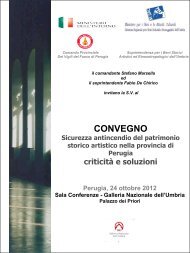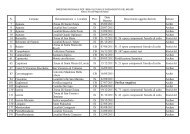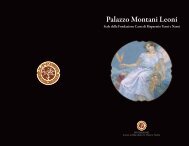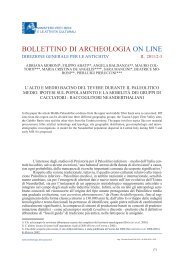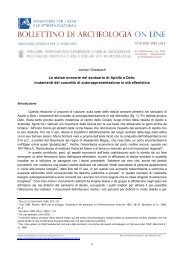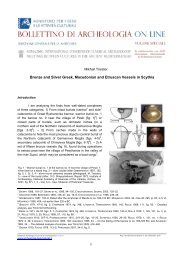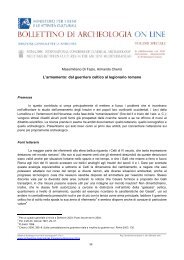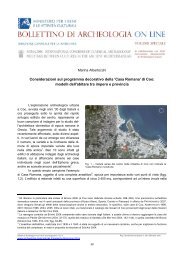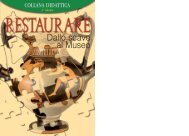Late Hellenistic Settlements in Hawrān (Southern Syria). Survival of ...
Late Hellenistic Settlements in Hawrān (Southern Syria). Survival of ...
Late Hellenistic Settlements in Hawrān (Southern Syria). Survival of ...
You also want an ePaper? Increase the reach of your titles
YUMPU automatically turns print PDFs into web optimized ePapers that Google loves.
Jérôme Rohmer<br />
<strong>Late</strong> <strong>Hellenistic</strong> <strong>Settlements</strong> <strong>in</strong> Hawrân (<strong>Southern</strong> <strong>Syria</strong>). <strong>Survival</strong> <strong>of</strong> Proto-historic<br />
Urbanism and Village Architecture <strong>in</strong> a Hellenized Context<br />
Introduction<br />
The other contributions to this session have focused on the genesis <strong>of</strong> cities <strong>in</strong> arid environments.<br />
The region which I discuss here presents us with a different case, s<strong>in</strong>ce it is not located with<strong>in</strong> the arid zone,<br />
but on its fr<strong>in</strong>ge. Hawrân is a semi-arid region which lies between the pla<strong>in</strong> <strong>of</strong> Damascus <strong>in</strong> the North and the<br />
Jordanian steppe <strong>in</strong> the South (fig. 1). It is delimited <strong>in</strong> the West by the Golan plateau and <strong>in</strong> the East by the<br />
arid steppes <strong>of</strong> as-Safa and al-Hamad. The entire region is volcanic and all its soils derive from basalt. It lies<br />
over the 200 mm isohyet, which makes ra<strong>in</strong> agriculture possible - though not necessarily reliable - <strong>in</strong> most <strong>of</strong><br />
its areas. In spite <strong>of</strong> these common features, climatic and pedological variations def<strong>in</strong>e several micro-regions<br />
with different environmental conditions and agricultural potential. In the South and the West, the plateaus <strong>of</strong><br />
Nuqrah and Jedur comprise ancient degraded soils and lie over the 250 mm isohyet, which allows for the<br />
practice <strong>of</strong> a relatively reliable cereal culture. In the East, the mounta<strong>in</strong>s <strong>of</strong> Jebel al-‘Arab enjoy particularly<br />
high rates <strong>of</strong> precipitations and are<br />
mostly suitable for tree cultivation. In the<br />
North, Leja (or Trachonitis) is a rocky<br />
enclave result<strong>in</strong>g from recent eruptions,<br />
with a very chaotic topography marked<br />
by depressions, rifts and ridges. Save<br />
for a few agricultural pockets spared by<br />
the lavas, its rocky soils and the scarcity<br />
<strong>of</strong> its vegetation only permit small-scale<br />
sheep or goat breed<strong>in</strong>g. In the <strong>Hellenistic</strong><br />
period, Hawrân was first a Lagid<br />
possession, as a part <strong>of</strong> Koile <strong>Syria</strong>. It<br />
fell under Seleucid rule after the battle<br />
<strong>of</strong> Panion <strong>in</strong> 200 BC. However, by the<br />
end <strong>of</strong> the 2 nd c. BC, the k<strong>in</strong>gs <strong>of</strong><br />
Antioch most likely did not exert anyth<strong>in</strong>g<br />
but a formal control over southern<br />
Fig. 1 – Map <strong>of</strong> Hawrân with localisation <strong>of</strong> the sites discussed.<br />
<strong>Syria</strong>. Hawrân became a battle-<br />
Bollett<strong>in</strong>o di Archeologia on l<strong>in</strong>e I 2010/ Volume speciale G / G5 / 2 Reg. Tribunale Roma 05.08.2010 n. 330 ISSN 2039 - 0076<br />
www.archeologia.beniculturali.it<br />
1
J. Rohmer - <strong>Late</strong> <strong>Hellenistic</strong> <strong>Settlements</strong> <strong>in</strong> Hawrân (<strong>Southern</strong> <strong>Syria</strong>). <strong>Survival</strong> <strong>of</strong> Proto-historic Urbanism and Village Architecture <strong>in</strong> a Hellenized<br />
Context<br />
ground for neighbour<strong>in</strong>g local powers, such as the Jewish Hasmonean State, the Nabataean k<strong>in</strong>gdom, and<br />
the Ituraean pr<strong>in</strong>cipality 1 . The southern part <strong>of</strong> the region, around the city <strong>of</strong> Bosra, was annexed by the<br />
Nabataean k<strong>in</strong>gdom <strong>in</strong> the late 2 nd or early 1 st c. BC. After the Roman conquest <strong>in</strong> 64 BC, Rome entrusted<br />
local client states with the task <strong>of</strong> ensur<strong>in</strong>g the stability <strong>of</strong> the northern part <strong>of</strong> the region, which had become<br />
a nest <strong>of</strong> bandits 2 . While the South rema<strong>in</strong>ed under Nabataean rule, the northern part was handed over to<br />
Herod <strong>in</strong> 20 BC. Hawrân rema<strong>in</strong>ed under Herodian and Nabataean rule throughout the 1 st c. AD, until it was<br />
eventually annexed by Rome at the turn <strong>of</strong> the 1 st and 2 nd c. AD 3 .<br />
Until recently, very few archaeological traces<br />
<strong>of</strong> this violent history had been found <strong>in</strong> the field. The<br />
first travellers and scholars essentially focused their<br />
attention on the rich Roman and Byzant<strong>in</strong>e rema<strong>in</strong>s <strong>of</strong><br />
the region 4 . However, fieldwork conducted s<strong>in</strong>ce 1974<br />
by the French Archaeological Expedition <strong>in</strong> <strong>Southern</strong><br />
<strong>Syria</strong> has generated new <strong>in</strong>formation on settlement<br />
patterns and on the material culture <strong>of</strong> these local<br />
“dark ages”. Most notably, a survey <strong>of</strong> the northern<br />
Jebel al-‘Arab and <strong>of</strong> the Leja plateau, as well as<br />
several excavations on key sites, have led to the<br />
discovery <strong>of</strong> several <strong>Late</strong> <strong>Hellenistic</strong> and “preprov<strong>in</strong>cial”<br />
settlements <strong>of</strong> significant importance (fig.<br />
1) 5 . On the basis <strong>of</strong> these results, my goal here is to<br />
address the morphological characteristics <strong>of</strong> these<br />
settlements, which attest to the survival <strong>of</strong> protohistoric<br />
traditions throughout the <strong>Hellenistic</strong> and “preprov<strong>in</strong>cial”<br />
periods, and which stand <strong>in</strong> stark contrast<br />
with the previous examples <strong>of</strong> urban genesis analysed<br />
dur<strong>in</strong>g this session. Indeed, these sites on the fr<strong>in</strong>ge <strong>of</strong><br />
the arid zone draw our attention to settlement schemes<br />
which radically differ from the progressive and<br />
dispersed mode <strong>of</strong> development hypothesized for the<br />
early phases <strong>of</strong> the “desert cities” 6 .<br />
Description <strong>of</strong> the Sites<br />
The Nuqrah and Jedur<br />
Only two cities are attested <strong>in</strong> the southern plateaus <strong>of</strong> Hawrân dur<strong>in</strong>g the <strong>Hellenistic</strong> period. To the<br />
East <strong>of</strong> Nuqrah, at the foot <strong>of</strong> the Jebel al-‘Arab mounta<strong>in</strong>s, Bosra was a prom<strong>in</strong>ent urban centre <strong>in</strong> the<br />
1<br />
See KASHER 1988 for a comprehensive study <strong>of</strong> these conflicts.<br />
2<br />
Josephus, AJ, 15.342–354; Strabo, Geography, 16.2.20.<br />
3<br />
The northern part <strong>of</strong> the region, which was under Herodian rule, was annexed to the Roman prov<strong>in</strong>ce <strong>of</strong> <strong>Syria</strong> either <strong>in</strong> 92 or <strong>in</strong> 96 AD<br />
The southern part, which was occupied by the Nabataeans, became part <strong>of</strong> the prov<strong>in</strong>ce <strong>of</strong> Arabia after Trajan’s conquest <strong>in</strong> 106 AD<br />
See SARTRE 2001, 469–527.<br />
4<br />
See, among others, BRÜNNOW and DOMASZEWSKI 1905-1909 for a compilation <strong>of</strong> previous travel narratives and expedition reports;<br />
BUTLER ET AL. 1914, 1914–1941; SARTRE-FAURIAT 2004.<br />
5<br />
In <strong>Southern</strong> <strong>Syria</strong>, the term “pre-prov<strong>in</strong>cial” applies to the period stretch<strong>in</strong>g from Pompey’s conquest to the eventual annexion by Rome<br />
at the turn <strong>of</strong> the 1st and 2nd c. AD<br />
6<br />
For Petra, see for <strong>in</strong>stance DENTZER, ZAYADINE 1992; DENTZER 1999, 237-239, and the contribution <strong>of</strong> S. Schmid to this session. For<br />
Palmyra, see for <strong>in</strong>stance WILL 1983; DENTZER, SAUPIN 1996, and the contribution <strong>of</strong> M. Hamad to this session.<br />
Bollett<strong>in</strong>o di Archeologia on l<strong>in</strong>e I 2010/ Volume speciale G / G5 / 2 Reg. Tribunale Roma 05.08.2010 n. 330 ISSN 2039 - 0076<br />
www.archeologia.beniculturali.it<br />
2<br />
Fig. 2 – Bosra: aerial view <strong>of</strong> the tell (BRAEMER 2002, fig. 2).
XVII International Congress <strong>of</strong> Classical Archaeology, Roma 22-26 Sept. 2008<br />
Session: Formation d’une culture urba<strong>in</strong>e aux marges du désert syro-arabique: espaces urba<strong>in</strong>s et périurba<strong>in</strong>s<br />
Middle Bronze Age. The wide tell which lies <strong>in</strong> the western part <strong>of</strong> the city dates back to this period (fig. 2) 7 .<br />
The city reappears <strong>in</strong> the historical record <strong>in</strong> the first half <strong>of</strong> the 2 nd c. BC, as the first book <strong>of</strong> the Maccabees<br />
reports an expedition <strong>of</strong> Juda and Jonathan Maccabee aga<strong>in</strong>st Bosra <strong>in</strong> the years 164-163 8 . The city was<br />
probably annexed by the Nabataean k<strong>in</strong>gdom at the end <strong>of</strong> the 2 nd c. BC, although there is no epigraphic<br />
evidence for the presence <strong>of</strong> Nabataeans until the 1 st c. AD 9 . Most <strong>of</strong> the archaeological rema<strong>in</strong>s which are<br />
visible today date back to the Roman and Byzant<strong>in</strong>e period. However, the excavations carried out by the<br />
French Expedition s<strong>in</strong>ce 1981 provide new clues as to the probable location <strong>of</strong> the <strong>Hellenistic</strong> settlement.<br />
New sound<strong>in</strong>gs <strong>in</strong> the western part <strong>of</strong> the city suggest that the ancient tell was occupied at least until the Iron<br />
Age II, and that its western rampart was rebuilt <strong>in</strong> the late 1 st c. BC 10 . Conversely, deep sound<strong>in</strong>gs conducted<br />
<strong>in</strong> the monumental area, i.e. the central and eastern parts <strong>of</strong> Bosra, have shown very few traces <strong>of</strong><br />
occupation prior to the reign <strong>of</strong> the Nabataean k<strong>in</strong>g Rabbel II, <strong>in</strong> the second half <strong>of</strong> the 1 st c. AD 11. These data<br />
suggest that the city rema<strong>in</strong>ed conf<strong>in</strong>ed to the old fortified tell until a relatively late date. Unfortunately, save<br />
for its location, the features <strong>of</strong> the <strong>Hellenistic</strong> agglomeration rema<strong>in</strong> so far completely unknown. It is also<br />
unclear whether the occupation <strong>of</strong> the tell was cont<strong>in</strong>uous between Iron Age II and the <strong>Hellenistic</strong> period.<br />
In the South-western part <strong>of</strong> Hawrân, on the Jedur plateau, the city <strong>of</strong> Dion or Diospolis - which until<br />
recently was only known through literary references - should most certa<strong>in</strong>ly be identified with Tell al-Ash‘ari,<br />
on the banks <strong>of</strong> a major affluent <strong>of</strong> the Yarmuk river 12 . The site is be<strong>in</strong>g excavated by a <strong>Syria</strong>n expedition led<br />
by Q. al-Mohammed. Although the story <strong>of</strong> its foundation by Alexander is probably legendary, it was an<br />
important urban centre by the beg<strong>in</strong>n<strong>in</strong>g <strong>of</strong> the 1 st c. BC, and it belonged to the Decapolis 13 . For the time<br />
be<strong>in</strong>g, no <strong>in</strong>formation is available concern<strong>in</strong>g the urban development <strong>of</strong> the city <strong>in</strong> the <strong>Hellenistic</strong> period, as<br />
the excavated monuments seem to date back to the 2 nd c. AD at the earliest. The date <strong>of</strong> the foundation <strong>of</strong><br />
the <strong>Hellenistic</strong> city, as well as the cont<strong>in</strong>uity <strong>of</strong> occupation between the Iron Age and the <strong>Hellenistic</strong> period,<br />
are still pend<strong>in</strong>g issues. However, it is <strong>in</strong>terest<strong>in</strong>g to note that the <strong>Hellenistic</strong> and Roman city has developed<br />
on a 10 ha fortified tell, whose occupation dates back to the Middle Bronze Age.<br />
The Jebel al–‘Arab<br />
In the Jebel al-‘Arab, the only polis attested <strong>in</strong> the <strong>Hellenistic</strong> period is Qanawât/Canatha, on the<br />
western slopes <strong>of</strong> the mounta<strong>in</strong>. A member <strong>of</strong> the Decapolis, Canatha was founded (or refounded) <strong>in</strong> the<br />
years follow<strong>in</strong>g Pompey’s conquest s<strong>in</strong>ce it bears the epithet Gab<strong>in</strong>ia on some <strong>of</strong> its co<strong>in</strong>s 14 . However, no<br />
def<strong>in</strong>ite traces <strong>of</strong> the <strong>Hellenistic</strong> phases <strong>of</strong> the city have been uncovered so far. The dat<strong>in</strong>g <strong>of</strong> a number <strong>of</strong><br />
monuments (temples, nymphaeum, odeon, tombs) <strong>in</strong> the second half <strong>of</strong> the 1 st c. BC rests on purely<br />
typological arguments and f<strong>in</strong>ds no consensus among scholars 15 . It must therefore be taken with great<br />
caution.<br />
The <strong>Hellenistic</strong> phases are better documented <strong>in</strong> the neighbour<strong>in</strong>g city <strong>of</strong> Suweida/Soada, which is<br />
located some 7 km south <strong>of</strong> Qanawât, at the <strong>in</strong>terface between the mounta<strong>in</strong>s and the pla<strong>in</strong> (fig. 3). Until<br />
recently, Soada was considered a prosperous village which progressively grew <strong>in</strong>to a city <strong>in</strong> the Roman<br />
period. However, a campaign <strong>of</strong> excavations and surveys conducted between 1996 and 1999 by M. Kalos<br />
and F. Renel has significantly changed this perception 16 . The campaign has led to the identification <strong>of</strong> a 3 ha<br />
walled tell <strong>in</strong> the heart <strong>of</strong> the old city. This agglomeration has an irregular oval form and is enclosed by two<br />
7<br />
DENTZER ET AL. 2002; SEEDEN 1986.<br />
8<br />
I Macc, 5, 28.<br />
9<br />
SARTRE 1985; 2001, 411–424; DENTZER-FEYDY ET AL. 2007.<br />
10<br />
BRAEMER 2002.<br />
11<br />
The only possibly earlier rema<strong>in</strong>s are those <strong>of</strong> a domestic unit under the western part <strong>of</strong> the southern baths. They are tentatively dated<br />
between the late 1 st c. BC and the 1 st c. AD, cf. DENTZER ET AL. 2002, 94.<br />
12 SARTRE 1992; KROPP, MOHAMMED 2006; MOHAMMED Forthcom<strong>in</strong>g.<br />
13 See SARTRE 1992 for the historical record on Dion.<br />
14 For a comprehensive study <strong>of</strong> the available historical record on Qanawât, see SARTRE 1992.<br />
15 See for <strong>in</strong>stance FREYBERGER 2004 vs. AUGIER, SARTRE 2001.<br />
16 KALOS 1999; DENTZER ET AL. 2010.<br />
Bollett<strong>in</strong>o di Archeologia on l<strong>in</strong>e I 2010/ Volume speciale G / G5 / 2 Reg. Tribunale Roma 05.08.2010 n. 330 ISSN 2039 - 0076<br />
www.archeologia.beniculturali.it<br />
3
J. Rohmer - <strong>Late</strong> <strong>Hellenistic</strong> <strong>Settlements</strong> <strong>in</strong> Hawrân (<strong>Southern</strong> <strong>Syria</strong>). <strong>Survival</strong> <strong>of</strong> Proto-historic Urbanism and Village Architecture <strong>in</strong> a Hellenized<br />
Context<br />
concentric ramparts, <strong>in</strong> between which build<strong>in</strong>gs<br />
(casemates?) may have existed. Photographs<br />
taken <strong>in</strong> the early 20 th century attest to the<br />
presence, <strong>in</strong>side the walls, <strong>of</strong> a wide and deep<br />
water tank, which probably reached down to the<br />
water table or to an underground spr<strong>in</strong>g. On the<br />
eastern end <strong>of</strong> the agglomeration, a citadel or<br />
palace with wide warehouses was built on 15 m<br />
high casemated substructions. Fragments <strong>of</strong><br />
mosaics were found <strong>in</strong> one <strong>of</strong> the ma<strong>in</strong> rooms.<br />
Although the fortifications <strong>of</strong> the tell probably<br />
date back to the Iron or Bronze Age, the construction<br />
<strong>of</strong> the citadel took place <strong>in</strong> the mid-2 nd c.<br />
BC. It is unclear so far whether the tell was<br />
cont<strong>in</strong>uously occupied between Iron Age II and<br />
the <strong>Hellenistic</strong> period. It was probably abandoned<br />
<strong>in</strong> the course <strong>of</strong> the 1 st c. BC, and the Roman city <strong>of</strong> Soada/Dionysias expanded, from the 1 st c. AD<br />
onwards, at the foot <strong>of</strong> the ancient tell.<br />
In spite <strong>of</strong> the archaiz<strong>in</strong>g organization <strong>of</strong> the city, the fragments <strong>of</strong> mosaics and the largely Hellenized<br />
pottery repertoire found <strong>in</strong> the citadel imply a quite significant penetration <strong>of</strong> <strong>Hellenistic</strong> culture and social<br />
practices among the rul<strong>in</strong>g class <strong>of</strong> the city 17 . The most ancient tombs excavated <strong>in</strong> the necropoleis <strong>of</strong> the<br />
city confirm this trend. A mausoleum reported and drawn by de Voguë at the end <strong>of</strong> the 19 th c. (Hamrath’s<br />
tomb) reflects a good knowledge <strong>of</strong> <strong>Hellenistic</strong> architectural and decorative vocabulary, probably as early as<br />
the beg<strong>in</strong>n<strong>in</strong>g <strong>of</strong> the 1 st c. BC 18 . It is a square monument built on a krepis, with engaged Doric columns and<br />
an regular Doric entablature. Between the columns are armorial ornaments typical <strong>of</strong> the <strong>Hellenistic</strong> tradition:<br />
a Macedonian helmet, an oval shield and a cuirass with long flaps. Additionally, excavations <strong>of</strong> a late 1 st c.<br />
BC tumuli have provided a couple <strong>of</strong> ladles with zoomorphic handles (simpula), together with table<br />
amphorae: these f<strong>in</strong>ds are evidence <strong>of</strong> the practice <strong>of</strong> funerary banquets <strong>in</strong> a Hellenized way 19 .<br />
The archaiz<strong>in</strong>g architecture <strong>of</strong> the citadel <strong>of</strong> Suweida f<strong>in</strong>ds echoes among the contemporary<br />
settlements so far identified <strong>in</strong><br />
Jebel al-‘Arab. Tell Jubeh,<br />
located some 10 km north <strong>of</strong><br />
Suweida, is a very wide promontory<br />
stronghold (280 x 65<br />
m) built on the ridge <strong>of</strong> an<br />
ext<strong>in</strong>ct volcano, and consist<strong>in</strong>g<br />
<strong>of</strong> two small citadels l<strong>in</strong>ked by<br />
an impressive megalithic casemate<br />
wall (fig. 4) 20 Fig. 3 – The tell <strong>of</strong> Suweida (after DENTZER ET AL. 2010, fig. 9).<br />
. The casemates<br />
are adjo<strong>in</strong><strong>in</strong>g but architecturally<br />
<strong>in</strong>dependent. They<br />
open onto a wide central<br />
Fig. 4 – Plan <strong>of</strong> Tell Jubeh (courtesy F. BRAEMER).<br />
courtyard, which is devoid <strong>of</strong><br />
constructions. The only <strong>in</strong>ternal<br />
structure is a circular birkeh<br />
17<br />
RENEL 2010a.<br />
18<br />
VOGÜÉ 1865-67, 29; BUTLER ET AL. 1914, vol. 2, 324–326; DENTZER-FEYDY 1986, 263–265.<br />
19<br />
RENEL 2010b.<br />
20<br />
BRAEMER 1984, 246, fig. 37-38. For prelim<strong>in</strong>ary comments on the pottery <strong>of</strong> this site, see RENEL 2010a.<br />
Bollett<strong>in</strong>o di Archeologia on l<strong>in</strong>e I 2010/ Volume speciale G / G5 / 2 Reg. Tribunale Roma 05.08.2010 n. 330 ISSN 2039 - 0076<br />
www.archeologia.beniculturali.it<br />
4
XVII International Congress <strong>of</strong> Classical Archaeology, Roma 22-26 Sept. 2008<br />
Session: Formation d’une culture urba<strong>in</strong>e aux marges du désert syro-arabique: espaces urba<strong>in</strong>s et périurba<strong>in</strong>s<br />
(open air water tank) <strong>in</strong> the centre. The courtyard was probably used for keep<strong>in</strong>g herds 21 . Recent surveys<br />
conducted on the site have brought new evidence for the date <strong>of</strong> this settlement. Clandest<strong>in</strong>e excavations<br />
made by the locals have brought to light a large amount <strong>of</strong> sherds com<strong>in</strong>g from complete forms which were<br />
probably <strong>in</strong> situ when the casemates were plundered. This material is very homogeneous and allows us to<br />
date the construction and occupation <strong>of</strong> the site to a short period between the mid-2 nd c. and the mid-1 st c.<br />
BC. The absence <strong>of</strong> pottery f<strong>in</strong>ds on the surface <strong>in</strong> and around the site confirms a silentio the hypothesis <strong>of</strong> a<br />
very short-lived occupation. Among the material brought to light by the clandest<strong>in</strong>e excavations, the<br />
significant proportion <strong>of</strong> locally made table amphorae is perhaps to be related to the adoption <strong>of</strong> Helleniz<strong>in</strong>g<br />
social practices (banquet<strong>in</strong>g). At any rate, it <strong>in</strong>dicates the assimilation <strong>of</strong> a Hellenized repertoire by local<br />
potters <strong>in</strong> the 2 nd half <strong>of</strong> the 2 nd c. BC.<br />
Some 3 km south <strong>of</strong> this site, the village <strong>of</strong><br />
Sî‘ has a different but equally archaiz<strong>in</strong>g layout 22 .<br />
The site is located on a wide promontory and it<br />
covers approximately 5 ha (450 x 130 m). It is<br />
surrounded by a 5 to 8,5 m thick curved rampart,<br />
parts <strong>of</strong> which may have had casemates. The<br />
<strong>in</strong>side space is very densely built with relatively<br />
orthogonal blocks <strong>of</strong> houses. The first phase <strong>of</strong> the<br />
rampart and <strong>of</strong> the excavated houses dates back to<br />
the late 1 st c. BC 23 . Next to the village, on the west<br />
end <strong>of</strong> the promontory, lies a sanctuary <strong>in</strong>clud<strong>in</strong>g<br />
three temenè, the first <strong>of</strong> which (dedicated to<br />
Baalshamîn) was probably built <strong>in</strong> the last third <strong>of</strong><br />
the 1 st c. BC As shown by J. Dentzer-Feydy, its<br />
temple comb<strong>in</strong>es a local architectural layout with<br />
elements <strong>of</strong> Hellenized stone decoration 24 .<br />
Bollett<strong>in</strong>o di Archeologia on l<strong>in</strong>e I 2010/ Volume speciale G / G5 / 2 Reg. Tribunale Roma 05.08.2010 n. 330 ISSN 2039 - 0076<br />
www.archeologia.beniculturali.it<br />
5<br />
Leja (Trachonitis)<br />
In the neighbour<strong>in</strong>g volcanic plateau called<br />
Leja or Trachonitis, a recent survey supervised by<br />
F. Braemer has revealed an unexpected number <strong>of</strong><br />
human settlements <strong>of</strong> all proto-historic and historical<br />
periods 25 . Among these are some great tells,<br />
cover<strong>in</strong>g a surface <strong>of</strong> several hectares, with phases<br />
<strong>of</strong> occupation stretch<strong>in</strong>g from the Middle Bronze<br />
Age to the Early Roman period. Unfortunately, it is<br />
difficult to assess the nature and the importance <strong>of</strong> the <strong>Hellenistic</strong> occupation on these multi-period sites on<br />
the sole basis <strong>of</strong> survey results. However, recent <strong>Syria</strong>n excavations at Tell Debbeh, one <strong>of</strong> the major tells <strong>of</strong><br />
the region, suggest the existence <strong>of</strong> a late <strong>Hellenistic</strong> stratum (late 2 nd c. BC - 1 c. AD), subsequent to the<br />
abandonment <strong>of</strong> the site at the end <strong>of</strong> Iron Age II 26 Fig. 5 – Kreim aj-Janoûbi: plan <strong>of</strong> the visible rema<strong>in</strong>s.<br />
. Consequently, it is probable that a number <strong>of</strong> these<br />
ancient fortified tells still played a large role dur<strong>in</strong>g the late <strong>Hellenistic</strong> period.<br />
21 See ROUTLEDGE 2000, 59 for a discussion <strong>of</strong> this feature <strong>in</strong> similar Iron Age 1 settlements. The function <strong>of</strong> such central courtyards <strong>in</strong><br />
the Iron Age Negev “fortresses” has recently been demonstrated by geoarchaeological and isotopic analyses: see SHAHACK-GROSS,<br />
FINKELSTEIN 2008.<br />
22 DENTZER ET AL. 1985; VILLENEUVE Forthcom<strong>in</strong>g.<br />
23 DENTZER ET AL. 1985, 75–80; VILLENEUVE Forthcom<strong>in</strong>g.<br />
24 DENTZER-FEYDY 1986, 265–269.<br />
25 CRIAUD, ROHMER 2010; ROHMER 2010.<br />
26 ABOU ASSAF 2005.
J. Rohmer - <strong>Late</strong> <strong>Hellenistic</strong> <strong>Settlements</strong> <strong>in</strong> Hawrân (<strong>Southern</strong> <strong>Syria</strong>). <strong>Survival</strong> <strong>of</strong> Proto-historic Urbanism and Village Architecture <strong>in</strong> a Hellenized<br />
Context<br />
Apart from these major tells, smaller s<strong>in</strong>gle-period agglomerations provide <strong>in</strong>sight <strong>in</strong>to local trends <strong>in</strong><br />
town-plann<strong>in</strong>g and village architecture at the end <strong>of</strong> the <strong>Hellenistic</strong> period. Located on the western border <strong>of</strong><br />
the Leja, the agglomeration <strong>of</strong> Kreim aj-Janoûbi probably had a short-lived occupation dur<strong>in</strong>g the 1 st c. BC<br />
and maybe the first half <strong>of</strong> the 1 st c. AD (fig. 5) 27 . It is a 2.5 ha oval settlement (200 x 140 m) located on a<br />
basaltic platform, 1 km far from the agricultural plateau <strong>of</strong> Jedur. It is surrounded by an impressive double<br />
wall. The 5 to 7 m wide space between the outer and the <strong>in</strong>ner wall is filled with blocks, which may<br />
correspond either to collapsed build<strong>in</strong>gs or to a slop<strong>in</strong>g glacis. Besides, it is uncerta<strong>in</strong> yet whether the <strong>in</strong>ner<br />
wall was entirely filled with rubble or whether it had <strong>in</strong>ternal casemates at some po<strong>in</strong>ts <strong>of</strong> its course. Inside<br />
the settlement, a large depression corresponds to an ancient water reservoir, which, accord<strong>in</strong>g to the locals,<br />
was connected to an underground spr<strong>in</strong>g before it was blocked up by the Ottoman army. The <strong>in</strong>terior <strong>of</strong> the<br />
agglomeration is occupied by wide houses with courtyards or enclosures. Surface pottery f<strong>in</strong>ds <strong>in</strong>cluded a<br />
Greco-italic amphora <strong>of</strong> the 1 st c. BC<br />
and many pa<strong>in</strong>ted sherds (jugs, jars)<br />
which may have been imported from<br />
the neighbour<strong>in</strong>g regions <strong>of</strong> Golan or<br />
Galilee 28 .<br />
The nearby site <strong>of</strong> Khirbet<br />
‘Arish has a different layout (fig. 6). It<br />
is located on a basaltic platform <strong>in</strong> a<br />
very rocky environment, 1.5 km away<br />
from the nearest agricultural lands.<br />
Here, several rectangular pillared<br />
rooms with partition walls were built<br />
on the edge <strong>of</strong> the platform. All <strong>of</strong><br />
them open towards the <strong>in</strong>terior <strong>of</strong> the<br />
settlement, and most <strong>of</strong> them form<br />
several clusters (houses?) organised<br />
around common courtyards. The<br />
outer walls <strong>of</strong> the rooms are bl<strong>in</strong>d<br />
and were connected by segments <strong>of</strong><br />
walls <strong>in</strong> order to form a cont<strong>in</strong>uous<br />
“rampart.” The enclosed area covers<br />
approximately 0.8 ha (160 X 65 m).<br />
Only one house, with a front courtyard,<br />
is built outside <strong>of</strong> this rampart.<br />
The surface material conta<strong>in</strong>s a large proportion <strong>of</strong> imported pa<strong>in</strong>ted pottery, similar to that found <strong>in</strong> Kreim. It<br />
suggests a short-lived occupation <strong>in</strong> the 1 st c. BC and the first half <strong>of</strong> the 1 st Fig. 6 – Khirbet 'Arish: schematic plan <strong>of</strong> the visible rema<strong>in</strong>s.<br />
c. AD.<br />
The other <strong>Hellenistic</strong> or “pre-prov<strong>in</strong>cial” sites <strong>of</strong> Trachonitis have been significantly reoccupied <strong>in</strong> the<br />
Roman and Byzant<strong>in</strong>e periods. Consequently, there are very few clues to their <strong>in</strong>itial organization.<br />
Discussion<br />
An Anachronistic Architectural Morphology?<br />
Although they vary <strong>in</strong> size and shape, the settlements described share some basic common<br />
features. All <strong>of</strong> them are built on heights - promontories, tells or basaltic platforms. They cover the entire<br />
27 ROHMER 2010, 130–131.<br />
28 RENEL 2010a.<br />
Bollett<strong>in</strong>o di Archeologia on l<strong>in</strong>e I 2010/ Volume speciale G / G5 / 2 Reg. Tribunale Roma 05.08.2010 n. 330 ISSN 2039 - 0076<br />
www.archeologia.beniculturali.it<br />
6
XVII International Congress <strong>of</strong> Classical Archaeology, Roma 22-26 Sept. 2008<br />
Session: Formation d’une culture urba<strong>in</strong>e aux marges du désert syro-arabique: espaces urba<strong>in</strong>s et périurba<strong>in</strong>s<br />
available surface. They are delimited by thick cont<strong>in</strong>uous ramparts, which follow the orography <strong>in</strong> order to<br />
maximize the defensive advantages <strong>of</strong>fered by the natural site. In most cases (Suweida, Tell Jubeh, Kreim<br />
aj-Janoûbi, Sî‘?), casemates were built <strong>in</strong>side or along the rampart. Most settlements have a more or less<br />
elaborate water management system, sometimes l<strong>in</strong>ked with the water table or a spr<strong>in</strong>g (Suweida, Kreim aj-<br />
Janoûbi), <strong>in</strong>side the walls.<br />
These common features call for comparisons with the architecture <strong>of</strong> proto-historic periods. The<br />
<strong>Hellenistic</strong> cities <strong>of</strong> Bosra and Dion owe their general form to the Middle Bronze Age tells. In Suweida, the<br />
cont<strong>in</strong>uous double rampart with casemates bears a certa<strong>in</strong> resemblance with Iron Age II cities <strong>of</strong> Palest<strong>in</strong>e,<br />
such as the f<strong>in</strong>al stratum <strong>of</strong> Beersheba 29 . In these ancient urban centres, the <strong>Hellenistic</strong> period does not<br />
signal a rupture with the orig<strong>in</strong>al layouts <strong>in</strong>herited from the Bronze and Iron Ages. Though not unattested <strong>in</strong><br />
the Near East, this strong urbanistic cont<strong>in</strong>uity between protohistoric periods and the <strong>Hellenistic</strong> phase is<br />
quite strik<strong>in</strong>g <strong>in</strong> Hawrân.<br />
More surpris<strong>in</strong>g is the fact that newly founded settlements cont<strong>in</strong>ue to adopt archaic layouts. The<br />
structure <strong>of</strong> Tell Jubeh, with its casemate wall, its wide <strong>in</strong>terior courtyard and its high citadels, is strik<strong>in</strong>gly<br />
ak<strong>in</strong> to that <strong>of</strong> some Iron Age 1 “enclosed settlements” on the plateaus <strong>of</strong> Transjordan, such as Khirbet al-<br />
Mudayna al-‘Alya on upper Wadi Mujib 30 . The oval double wall <strong>of</strong> Kreim aj-Janoûbi is rem<strong>in</strong>iscent <strong>of</strong> Bronze<br />
and Iron Age double-wall fortification systems 31 . As for Sî‘, the thick megalithic curved wall is also closer to<br />
the tradition <strong>of</strong> proto-historic ramparts than to the design <strong>of</strong> <strong>Hellenistic</strong> fortifications 32 .<br />
To the best <strong>of</strong> our knowledge, the survival <strong>of</strong> such archaic layouts until the 1 st c. AD is not common <strong>in</strong><br />
Near Eastern village architecture. In <strong>Hellenistic</strong> and Roman villages, the prevail<strong>in</strong>g mode <strong>of</strong> development<br />
seems to be characterized by the spontaneous and progressive “agglut<strong>in</strong>ation” <strong>of</strong> hous<strong>in</strong>g units with no prior<br />
plann<strong>in</strong>g 33 . When they have fortifications, these were usually built a posteriori, i.e. after the full development<br />
<strong>of</strong> the village. A similar model <strong>of</strong> development has been hypothesized for the “desert cities” previously<br />
discussed dur<strong>in</strong>g this session (Palmyra, Petra): their genesis is thought to result from the “synoikism” <strong>of</strong><br />
dispersed sub-urban nuclei, <strong>in</strong>itially quite distant from each other and grouped around tribal or familial<br />
sanctuaries 34 .<br />
On the contrary, most <strong>of</strong> the <strong>Late</strong> <strong>Hellenistic</strong> settlements <strong>of</strong> Hawrân <strong>in</strong>volve some degree <strong>of</strong> overall<br />
plann<strong>in</strong>g. Their basic morphological features suggest, for their <strong>in</strong>itial phase, a sudden, deliberate and<br />
purposeful settlement <strong>of</strong> relatively large human groups. Khirbet ‘Arish might be the only case <strong>of</strong> a<br />
spontaneous development result<strong>in</strong>g from the progressive agglut<strong>in</strong>ation <strong>of</strong> domestic units. In the other<br />
settlements, the def<strong>in</strong>ition <strong>of</strong> the settlement boundaries, clearly pre-dates the occupation <strong>of</strong> the <strong>in</strong>terior<br />
space. These sites were most probably fortified right from the beg<strong>in</strong>n<strong>in</strong>g, either with the construction <strong>of</strong> an<br />
<strong>in</strong>dependent rampart (Kreim aj-Janoûbi, Si‘) or through a specific layout <strong>of</strong> the external rooms (Tell Jubeh).<br />
Functional <strong>in</strong>terpretation<br />
In light <strong>of</strong> the specific characters <strong>of</strong> these sites with regard to contemporaneous Near Eastern<br />
urbanism and village architecture, it is more productive to th<strong>in</strong>k <strong>of</strong> their features <strong>in</strong> functional rather than <strong>in</strong><br />
“cultural” terms. From this po<strong>in</strong>t <strong>of</strong> view, both the layouts <strong>of</strong> the cities and <strong>of</strong> the villages may be considered<br />
as a response to a chronically unsafe environment. What appears at first sight is that their <strong>in</strong>habitants<br />
considered security a primary issue.<br />
29<br />
STERN ET AL. 1993, 167–173.<br />
30<br />
ROUTLEDGE 2000, fig. 4.<br />
31<br />
Double-wall fortifcation systems, usually with an <strong>in</strong>between glacis, are well known <strong>in</strong> Iron Age Palest<strong>in</strong>e and Transjordan, though at<br />
much larger sites. See for <strong>in</strong>stance Lachish IV-III (STERN ET AL. 1993, 906), Tel Batash III (STERN ET AL. 1993, 155), Tel Miqne/Ekron Ib<br />
(STERN ET AL. 1993, 1052–1057), Tel el-Hesi (STERN ET AL. 1993, 632–633), Tell Hamid (STERN ET AL. 2008, 1763), Tell el-‘Umeiri<br />
(STERN ET AL. 2008, 1849–1850). Early examples occur <strong>in</strong> the Middle Bronze Age (see e.g. Shechem: STERN ET AL. 1993, 1349).<br />
32<br />
DENTZER ET AL. 1985; VILLENEUVE Forthcom<strong>in</strong>g.<br />
33<br />
DENTZER, VILLENEUVE 1985.<br />
34<br />
For Petra, see among others DENTZER, ZAYADINE 1992; DENTZER 1999. For Palmyra see WILL 1983; DENTZER, SAUPIN 1996.<br />
Bollett<strong>in</strong>o di Archeologia on l<strong>in</strong>e I 2010/ Volume speciale G / G5 / 2 Reg. Tribunale Roma 05.08.2010 n. 330 ISSN 2039 - 0076<br />
www.archeologia.beniculturali.it<br />
7
J. Rohmer - <strong>Late</strong> <strong>Hellenistic</strong> <strong>Settlements</strong> <strong>in</strong> Hawrân (<strong>Southern</strong> <strong>Syria</strong>). <strong>Survival</strong> <strong>of</strong> Proto-historic Urbanism and Village Architecture <strong>in</strong> a Hellenized<br />
Context<br />
The <strong>Late</strong> <strong>Hellenistic</strong> period was one <strong>of</strong> great political <strong>in</strong>stability <strong>in</strong> Hawrân. In the southern Levant,<br />
the Seleucid authority was challenged by the emergence <strong>of</strong> powerful local states. Until the Roman conquest,<br />
the cities <strong>of</strong> southern Hawrân lived under the cont<strong>in</strong>uous threat <strong>of</strong> raids launched by these compet<strong>in</strong>g<br />
powers: Bosra was sacked by the Maccabees <strong>in</strong> 164/163 BC, together with other cities <strong>of</strong> the region, and<br />
Dion was violently conquered by Alexander Jannaeus at the beg<strong>in</strong>n<strong>in</strong>g <strong>of</strong> the 1 st c. BC 35 . The northern Jebel<br />
al-‘Arab was probably never annexed by these powers, save for a short period <strong>of</strong> Nabataean expansion<br />
towards the north, from 84 BC onwards. A passage <strong>of</strong> the Vita Isidori by Damascius, stat<strong>in</strong>g that “Bosra was<br />
fortified by the Arab k<strong>in</strong>gs aga<strong>in</strong>st its Dyonisian neighbours”, suggests that before the Roman conquest,<br />
Suweida had taken advantage <strong>of</strong> the political void to act as an autonomous local power 36 . The construction<br />
<strong>of</strong> the citadel on the fortified tell probably corresponds to these political developments. The contemporary<br />
settlement <strong>of</strong> Tell Jubeh, whatever its relationship with Suweida (allegiance, competition?), must probably be<br />
<strong>in</strong>terpreted <strong>in</strong> the same light. At any rate, the context <strong>of</strong> <strong>in</strong>stability and conflict which prevailed <strong>in</strong> the region<br />
from the mid-2 nd c. BC until the Roman conquest certa<strong>in</strong>ly accounts for the need to build heavy cont<strong>in</strong>uous<br />
fortifications as a prerequisite whenever a settlement was founded (Tell Jubeh). It may also expla<strong>in</strong> why the<br />
major cities <strong>of</strong> Hawrân (Dion, Bosra, Suweida) developed under the protection <strong>of</strong> their proto-historic<br />
fortifications, <strong>in</strong>stead <strong>of</strong> expand<strong>in</strong>g out <strong>of</strong> the tells.<br />
In the second half <strong>of</strong> the 1 st c. BC, <strong>in</strong> spite <strong>of</strong> the Roman conquest, the region was affected by<br />
another k<strong>in</strong>d <strong>of</strong> <strong>in</strong>stability. Josephus and Strabo describe Trachonitis as a nest <strong>of</strong> semi-nomadic bandits,<br />
liv<strong>in</strong>g <strong>in</strong> caves with their flocks and subsist<strong>in</strong>g ma<strong>in</strong>ly on robbery <strong>of</strong> the neighbour<strong>in</strong>g pla<strong>in</strong>s 37 . They report <strong>in</strong><br />
similar terms the compla<strong>in</strong>ts addressed to Augustus by the sedentary <strong>in</strong>habitants <strong>of</strong> the region aga<strong>in</strong>st these<br />
bandits, who took shelter <strong>in</strong> the rocky enclave <strong>of</strong> Trachonitis. This area was <strong>in</strong>deed an ideal refuge for<br />
bandits try<strong>in</strong>g to escape retaliation or repression. Its chaotic topology significantly h<strong>in</strong>ders visibility,<br />
circulation and orientation. Its “sub-basaltic corridors” (which fit quite well with Josephus’ and Strabo’s<br />
description <strong>of</strong> the bandits’ “dens”) are ideal hid<strong>in</strong>g places for clandest<strong>in</strong>e groups 38 . The present name <strong>of</strong> the<br />
area, Leja, predictably means “refuge” <strong>in</strong> Arabic. The <strong>in</strong>security favoured by these topographical specificities<br />
probably accounts for the existence <strong>of</strong> heavily fortified sites like Kreim aj-Janoûbi on the border <strong>of</strong><br />
Trachonitis.<br />
Anthropological clues<br />
Another explanatory factor for the layout <strong>of</strong> the sites is the nature <strong>of</strong> the populations <strong>in</strong>volved <strong>in</strong> the<br />
settlement process. In “desert cities” such as Petra or Palmyra, the dispersed mode <strong>of</strong> development has<br />
been generally <strong>in</strong>terpreted as the result <strong>of</strong> the progressive sedentarization <strong>of</strong> nomadic tribes 39 . The specific<br />
characters <strong>of</strong> the settlements under discussion may be the result <strong>of</strong> different anthropological conditions.<br />
The layout and the environment <strong>of</strong> the newly created settlements suggests that pastoralism played a<br />
prom<strong>in</strong>ent part <strong>in</strong> their economy. In Kreim aj-Janoûbi and Khirbet ‘Arish, the wide courtyards or enclosures<br />
associated with the domestic structures are probably to be related with sheep or goat breed<strong>in</strong>g. Both sites<br />
are located at a certa<strong>in</strong> distance (more than 1 km) from the nearest agricultural lands. The basaltic zone<br />
around Kreim aj-Janoûbi allows at best the practice <strong>of</strong> small-scale tree cultivation <strong>in</strong> micro-rifts. The<br />
environment <strong>of</strong> Khirbet ‘Arish is entirely rocky, without any agricultural potential, and the nearest agricultural<br />
lands have poor and stony soils. However, the area is marked by the presence <strong>of</strong> many large depressions<br />
which are filled with water <strong>in</strong> w<strong>in</strong>ter and <strong>in</strong> spr<strong>in</strong>g 40 . These depressions provide abundant dr<strong>in</strong>k<strong>in</strong>g water for<br />
herds. They were apparently used for this purpose until a recent period, s<strong>in</strong>ce many rema<strong>in</strong>s <strong>of</strong> Bedou<strong>in</strong><br />
camps are still visible today <strong>in</strong> the area. All this suggests that the economy <strong>of</strong> these settlements rested<br />
35<br />
See supra n. 8 and 13.<br />
36<br />
Photius, Bibliotheca, cod. 242, §196.<br />
37<br />
Josephus, AJ, 15.342–354; Strabo, Geography, 16.2.20.<br />
38<br />
VILLENEUVE 1985.<br />
39<br />
See supra n. 6.<br />
40<br />
See BRAEMER Forthcom<strong>in</strong>g for an analysis <strong>of</strong> this phenomenon.<br />
Bollett<strong>in</strong>o di Archeologia on l<strong>in</strong>e I 2010/ Volume speciale G / G5 / 2 Reg. Tribunale Roma 05.08.2010 n. 330 ISSN 2039 - 0076<br />
www.archeologia.beniculturali.it<br />
8
XVII International Congress <strong>of</strong> Classical Archaeology, Roma 22-26 Sept. 2008<br />
Session: Formation d’une culture urba<strong>in</strong>e aux marges du désert syro-arabique: espaces urba<strong>in</strong>s et périurba<strong>in</strong>s<br />
ma<strong>in</strong>ly on pastoralism. Part <strong>of</strong> their <strong>in</strong>habitants may have practiced tree cultivation <strong>in</strong> the neighbour<strong>in</strong>g area,<br />
or cereal culture <strong>in</strong> small distant parcels, but these were probably secondary activities 41 .<br />
Around Tell Jubeh, the slopes <strong>of</strong> the volcano bear the traces <strong>of</strong> ancient - though undated - terrace<br />
cultivation. Many collapsed terrace walls visible. The bottom <strong>of</strong> the small valley which the site overlooks<br />
comprises today small parcels <strong>of</strong> olive trees. However, the wide central courtyard, which is devoid <strong>of</strong><br />
constructions, is hardly understandable if not for keep<strong>in</strong>g livestock. The central birkeh was probably dug <strong>in</strong><br />
order provide water for the herds. Indeed, the water <strong>of</strong> such open air reservoirs is not suitable for human<br />
use. The economy <strong>of</strong> this settlement probably <strong>in</strong>cluded an prom<strong>in</strong>ent pastoral component, maybe comb<strong>in</strong>ed<br />
with tree cultivation.<br />
Though agropastoral, these newly created settlements do not necessarily result from the<br />
sedentarization <strong>of</strong> nomads. On the fr<strong>in</strong>ge <strong>of</strong> the sedentary zone, many rural communities are mobile, either<br />
partially (through a segmentation <strong>of</strong> the group) or totally (through yearly movements <strong>of</strong> transhumance) 42 . In<br />
Iron Age enclosed settlements <strong>of</strong> Palest<strong>in</strong>e and Transjordan - which <strong>of</strong>fer the closest parallels to the sites<br />
under <strong>in</strong>vestigation - the “sedentariz<strong>in</strong>g nomads” model is highly debated 43 . In the <strong>Hellenistic</strong> and Roman<br />
times, there is virtually no evidence for the presence <strong>of</strong> real nomads <strong>in</strong> Hawrân. As stressed by M.<br />
MacDonald, only a very marg<strong>in</strong>al number <strong>of</strong> “Safaitic” <strong>in</strong>scriptions were found <strong>in</strong> Hawrân, which suggests that<br />
the region did not belong to the transhumance area <strong>of</strong> the so-called “Safaitic” nomads 44 . Besides, the fact<br />
that no such <strong>in</strong>scriptions have been found <strong>in</strong>side the ancient villages makes it very unlikely that these<br />
nomads ever sedentarized <strong>in</strong> Hawrân. On the other hand, Zeno’s papyri and the book <strong>of</strong> the Maccabees<br />
mention Nabataean tribes graz<strong>in</strong>g or trad<strong>in</strong>g on the southern plateaus <strong>of</strong> the region <strong>in</strong> the 3 rd and 2 nd c. BC 45 .<br />
However, the latter text clearly dist<strong>in</strong>guishes the Nabataeans from the local population, and several pieces <strong>of</strong><br />
evidence (onomastics, material culture, cults) make it clear that the northern part <strong>of</strong> the region was neither<br />
settled nor politically dom<strong>in</strong>ated by the Nabataeans 46 . It is probable that even <strong>in</strong> the southern part, only<br />
Bosra, the regional capital, had a significant Nabataean population 47 . Most semitic <strong>in</strong>scriptions <strong>of</strong> northern<br />
Jebel al-‘Arab are written <strong>in</strong> local Aramaic, not <strong>in</strong> Nabataean 48 .<br />
Therefore, it is more cautious to th<strong>in</strong>k <strong>of</strong> these groups as new communities rather as sedentariz<strong>in</strong>g<br />
nomadic groups. This may be confirmed by the absence <strong>of</strong> any obvious k<strong>in</strong>ship-based organisation <strong>in</strong> Tell<br />
Jubeh, probably the best preserved settlement among those discussed here. This site is characterized by a<br />
uniform distribution <strong>of</strong> dist<strong>in</strong>ct s<strong>in</strong>gle casemate-like houses. Most houses have an <strong>in</strong>dependent door and<br />
open directly on the common central area (fig. 4). There are two clusters <strong>of</strong> rooms on the high citadels, but<br />
given their position they are better <strong>in</strong>terpreted <strong>in</strong> hierarchical (“palaces”) or functional (strongholds, fortified<br />
storage areas) terms. Here, the basic organizational unit seems to be that <strong>of</strong> the house, not that <strong>of</strong> larger<br />
k<strong>in</strong>ship groups. This is quite consistent with the hypothesis <strong>of</strong> a new community founded through the<br />
recruitment <strong>of</strong> displaced <strong>in</strong>dividuals or families.<br />
41 In some villages <strong>of</strong> Leja, there are still some semi-nomadic families, who cultivate small parcels <strong>of</strong> land and practice a six-month<br />
transhumance to the fertile plateaus <strong>of</strong> Jedur <strong>in</strong> summer (<strong>in</strong>terview with the Sâleh family <strong>in</strong> Sûr al-Leja, 15/05/2006). See also GUÉRIN<br />
2000.<br />
42 See MARFOE 1979 for examples <strong>of</strong> such phenomena <strong>in</strong> the pla<strong>in</strong> <strong>of</strong> Biq‘ <strong>in</strong> Lebanon.<br />
43 This model has been proposed by I. F<strong>in</strong>kelste<strong>in</strong> for the “enclosed settlements” <strong>of</strong> the Judean Highlands and the Negev (FINKELSTEIN<br />
1988 and 1995). His argumentation rests on the ecologically marg<strong>in</strong>al location <strong>of</strong> the sites, and on an architectural parallelism with some<br />
Bedou<strong>in</strong> camps <strong>of</strong> the early 20 th c. <strong>in</strong> the Negev desert. This model has been challenged by B. Routledge, who favours a dynamic <strong>of</strong><br />
“recruitment and attachment <strong>of</strong> displaced <strong>in</strong>dividual, families, and/or l<strong>in</strong>eages, regardless <strong>of</strong> their prior mode <strong>of</strong> production” (ROUTLEDGE<br />
2000, 60; 2004). Routledge criticizes the equation between pastoralism and nomadic orig<strong>in</strong>, and underl<strong>in</strong>es the fact that most<br />
ethnographically attested villages <strong>of</strong> sedentarized Bedou<strong>in</strong>s are unwalled and dispersed settlements.<br />
44 MCDONALD 1993.<br />
45<br />
DURAND 1997, n° 27.<br />
46<br />
VILLENEUVE 1985, 73–75.<br />
47<br />
SARTRE 1982.<br />
48<br />
STARCKY 1985, 173.<br />
Bollett<strong>in</strong>o di Archeologia on l<strong>in</strong>e I 2010/ Volume speciale G / G5 / 2 Reg. Tribunale Roma 05.08.2010 n. 330 ISSN 2039 - 0076<br />
www.archeologia.beniculturali.it<br />
9
J. Rohmer - <strong>Late</strong> <strong>Hellenistic</strong> <strong>Settlements</strong> <strong>in</strong> Hawrân (<strong>Southern</strong> <strong>Syria</strong>). <strong>Survival</strong> <strong>of</strong> Proto-historic Urbanism and Village Architecture <strong>in</strong> a Hellenized<br />
Context<br />
Conclusion<br />
In spite <strong>of</strong> their diversity, the <strong>Hellenistic</strong> and “pre-prov<strong>in</strong>cial” settlements discussed <strong>in</strong> this article<br />
suggest the existence <strong>of</strong> a regional trend characterized by the survival <strong>of</strong> proto-historic organizational<br />
features (location on promontories, massive curved ramparts, casemates). They reflect the persistence <strong>of</strong> a<br />
local urbanism and village architecture coexist<strong>in</strong>g with the diffusion <strong>of</strong> <strong>Hellenistic</strong> culture and social practices,<br />
for which there is is evidence <strong>in</strong> other aspects <strong>of</strong> the material culture (pottery f<strong>in</strong>ds, architectural decoration<br />
<strong>of</strong> tombs and temples). More surpris<strong>in</strong>gly, this regional trend also stands <strong>in</strong> stark contrast with the<br />
morphology <strong>of</strong> most spontaneous (i.e. not supervised by a superior political authority) settlements <strong>of</strong> the<br />
<strong>Hellenistic</strong> and Roman periods <strong>in</strong> the Near East. As opposed to the well documented dispersed or<br />
“agglut<strong>in</strong>at<strong>in</strong>g” modes <strong>of</strong> development, the settlements described here were <strong>in</strong>itially delimited <strong>in</strong> space, and<br />
they were purposefully —though broadly— organized from the moment <strong>of</strong> their foundation. These specific<br />
features may be expla<strong>in</strong>ed by the chronic <strong>in</strong>security attested <strong>in</strong> the region <strong>in</strong> the 2 nd and 1 st c. BC, which<br />
generated specific organizational constra<strong>in</strong>ts. They can also be <strong>in</strong>terpreted <strong>in</strong> anthropological terms, s<strong>in</strong>ce,<br />
as opposed to the prevail<strong>in</strong>g model <strong>in</strong> the arid and semi-arid zones several <strong>of</strong> these sites apparently result<br />
from the sudden settlement <strong>of</strong> new communities, rather than from the progressive sedentarization <strong>of</strong><br />
nomadic groups. On the basis <strong>of</strong> these prelim<strong>in</strong>ary observations, further research and fieldwork will now be<br />
needed to <strong>in</strong>vestigate more precisely the extent and the dat<strong>in</strong>g <strong>of</strong> this wave <strong>of</strong> archaiz<strong>in</strong>g settlements, and to<br />
understand its mean<strong>in</strong>g with<strong>in</strong> the turbulent history <strong>of</strong> late <strong>Hellenistic</strong> <strong>Southern</strong> <strong>Syria</strong>.<br />
Bibliography<br />
Bollett<strong>in</strong>o di Archeologia on l<strong>in</strong>e I 2010/ Volume speciale G / G5 / 2 Reg. Tribunale Roma 05.08.2010 n. 330 ISSN 2039 - 0076<br />
www.archeologia.beniculturali.it<br />
10<br />
Jérôme Rohmer<br />
Université Paris I, Panthéon-Sorbonne<br />
E-mail: jerohmer@gmail.com<br />
ABOU ASSAF A., 2005. Prelim<strong>in</strong>ary Report on the Excavations at Tell ad-Dibbah (Soueida) dur<strong>in</strong>g the first two<br />
campaigns, 2003-2004 (<strong>in</strong> Arabic). Annales archéologiques arabes syriennes, 47/48, 91–148.<br />
AUGIER Y., SARTRE M., 2001. Le dieu de Rabbos, maître du "temple périptère" de Canatha. DaM, 13, 125–<br />
130.<br />
BRAEMER F., 1984. Prospections archéologiques dans le Hawran (Syrie). <strong>Syria</strong>, 61, 219–250.<br />
BRAEMER F., 2002. Le rempart de Bosra au II e millénaire avant notre ère. <strong>Syria</strong>, 79, 65–74.<br />
BRAEMER F., 2009. L’eau du Hawran. Captages et gestion depuis le Bronze ancien. In M. AL-DBIYAT, M.<br />
MOUTON (eds), Stratégies d’acquisition de l’eau au Moyen-Orient depuis l’Antiquité. Beyrouth, 46–<br />
68.<br />
BRÜNNOW R. E., DOMASZEWSKI A. VON, 1905-1909. Die Prov<strong>in</strong>cia Arabia. Strasbourg.<br />
BUTLER H. C. ET AL.1914. Publications <strong>of</strong> an American Expedition to <strong>Syria</strong> <strong>in</strong> 1899-1900. New York.<br />
BUTLER H. C. ET AL.1914-1941. Publications <strong>of</strong> the Pr<strong>in</strong>ceton University Archaeological Expedition to <strong>Syria</strong> <strong>in</strong><br />
1904-1905 and 1909. Leyden.<br />
CRIAUD H., ROHMER J., 2010. Schémas d’occupation d’une enclave semi-aride: le Leja (Syrie du Sud), de<br />
l’âge du Bronze à la veille de l’annexion à Rome (3600 av. J.-C. – f<strong>in</strong> du I er s. ap. J.-C.). In H.<br />
ALARASHI, M.-L. CHAMBRADE, S. GONDET, A. JOUVENEL, C. SAUVAGE, H. TRONCHERE (eds), Regards<br />
croisés sur l’étude des paysages anciens. Nouvelles recherches dans le bass<strong>in</strong> méditerranéen, en<br />
Asie Centrale et au Proche et au Moyen-Orient. Actes du Colloque Broaden<strong>in</strong>g Horizons 2 (Lyon,18-<br />
20 ju<strong>in</strong> 2007). Lyon, 43-63.
XVII International Congress <strong>of</strong> Classical Archaeology, Roma 22-26 Sept. 2008<br />
Session: Formation d’une culture urba<strong>in</strong>e aux marges du désert syro-arabique: espaces urba<strong>in</strong>s et périurba<strong>in</strong>s<br />
DENTZER J.-M. 1999. L'espace des tribus arabes à l'époque hellénistique et roma<strong>in</strong>e: nomadisme,<br />
sédentarisation, urbanisation. CRAI, 231–271.<br />
DENTZER J.-M., BRAEMER F., DENTZER-FEYDY J., 1985. Six campagnes de fouilles à Sî‘. Développement et<br />
culture <strong>in</strong>digène en Syrie méridionale. DaM, 2, 65–83.<br />
DENTZER J.-M., VILLENEUVE F., 1985. Les villages du Hauran roma<strong>in</strong> dans une tradition d’urbanisme oriental.<br />
In J.-L. HUOT, M. YON, Y. CALVET (eds), Recueil Jean Deshayes: De l'Indus aux Balkans. Paris, 213–<br />
248.<br />
DENTZER J.-M., ZAYADINE F., 1992. L’espace urba<strong>in</strong> de Pétra. In M. ZAGHLOUL, A. HADIDI (eds), Studies <strong>in</strong> the<br />
history and archaeology <strong>of</strong> Jordan. IV. Fourth Conference on the History and Archaeology <strong>of</strong> Jordan<br />
held <strong>in</strong> Lyon. Amman, 233–251.<br />
DENTZER J.-M., SAUPIN R., 1996. L’espace urba<strong>in</strong> à Palmyre. Remarques sur des photographies aériennes<br />
anciennes. Annales archéologiques arabes syriennes, 42, 297–318.<br />
DENTZER J.-M., BLANC P.-M, FOURNET T., 2002. Le développement urba<strong>in</strong> de Bosra de l'époque nabatéenne<br />
à l'époque byzant<strong>in</strong>e: bilan des recherches françaises (1981-2002). <strong>Syria</strong>, 79, 75–154.<br />
DENTZER J.-M., BLANC P.-M., FOURNET T., KALOS M., RENEL F., 2010. Formation et développement des villes<br />
en Syrie du Sud de l’époque hellénistique à l’époque byzant<strong>in</strong>e: les exemples de Bosra, Suweida,<br />
Shahba. In M. AL-MAQDISSI, F. BRAEMER, J.-M. DENTZER (eds), Hauran V. La Syrie du Sud du<br />
Néolithique à l’Antiquité tardive. Actes du Colloque de Damas (2007), Volume I. Beyrouth, 139–169.<br />
DENTZER-FEYDY J., 1986. Décor architectural et développement du Hauran dans l’antiquité du I er s. av. J.-C.<br />
au VII e s. de notre ère. In J.-M. DENTZER (ed), Hauran I: Recherches archéologiques sur la Syrie du<br />
Sud à l’époque hellénistique et roma<strong>in</strong>e. Paris, 261–309.<br />
DENTZER-FEYDY J., 2010. Les sanctuaires païens de type régional en Syrie du Sud. In M. AL-MAQDISSI, F.<br />
BRAEMER, J.-M. DENTZER (eds), Hauran V. La Syrie du Sud du Néolithique à l’Antiquité tardive. Actes<br />
du Colloque de Damas (2007), Volume I. Beyrouth, 225–238.<br />
DENTZER-FEYDY J., VALLERIN M., FOURNET T., MUKDAD R. and A., 2007. Bosra. Aux portes de l’Arabie. Guides<br />
archéologiques de l’Institut Français du Proche-Orient, 5. Beyrouth, Damas, Amman.<br />
DURAND X., 1997. Des Grecs en Palest<strong>in</strong>e au III ème siècle av. J.-C. Le dossier syrien des archives de Zénon<br />
de Caunos (261-252). Paris.<br />
FINKELSTEIN I., 1988. The Archaeology <strong>of</strong> the Israelite Settlement. Jerusalem.<br />
FINKELSTEIN I., 1995. Liv<strong>in</strong>g on the Fr<strong>in</strong>ge: the Archaeology and History <strong>of</strong> the Negev S<strong>in</strong>ai and Neighbour<strong>in</strong>g<br />
Regions <strong>in</strong> the Bronze and Iron Ages. Sheffield.<br />
FREYBERGER K. S., 2004. Späthellenistische und frühkaiserzeitliche Kultbauten <strong>in</strong> Kanatha: Manifestation<br />
e<strong>in</strong>es neuen Selbstverständnisses regionaler Geme<strong>in</strong>den <strong>in</strong> Südsyrien. In E.-L. SCHWANDNER, K.<br />
RHEIDT (ed), Macht der Architektur, Architektur der Macht. Bauforschungskolloquium <strong>in</strong> Berl<strong>in</strong> (30.10.<br />
-2.11.2002). Ma<strong>in</strong>z am Rhe<strong>in</strong>, 263–273.<br />
GUERIN A., 2000. Architecture villageoise et tribu nomade. Déf<strong>in</strong>ition d'un peuplement dans le Lega à la<br />
période islamique (Syrie méridionale). Berytus, 44, 79–108.<br />
KALOS M., 1999. Soada-Dionysias: une ville sous la ville. Le Monde de la Bible, 118, 73.<br />
KASHER A., 1988. Jews, Idumaeans and Ancient Arabs. Relations <strong>of</strong> the Jews <strong>in</strong> Eretz-Israel with the Nations<br />
<strong>of</strong> the Frontier ad the Desert dur<strong>in</strong>g the <strong>Hellenistic</strong> and Roman Era (332 BCE - 70 CE). Tüb<strong>in</strong>gen.<br />
KROPP A., MOHAMMAD Q., 2006. Dion <strong>of</strong> the Decapolis: Tell al-Ash'ari <strong>in</strong> southern <strong>Syria</strong> <strong>in</strong> the light <strong>of</strong> ancient<br />
documents and recent discoveries. Levant, 38, 125–44.<br />
MARFOE L., 1979. The Integrative Transformation: Patterns <strong>of</strong> Sociopolitical Organization <strong>in</strong> <strong>Southern</strong> <strong>Syria</strong>.<br />
BASOR, 234, 1–42.<br />
MOHAMMAD Q., Forthcom<strong>in</strong>g. Tell Ach‘ari. In M. AL-MAQDISSI, F. BRAEMER, J.-M. DENTZER (eds), Hauran V. La<br />
Syrie du Sud du Néolithique à l’Antiquité tardive. Actes du Colloque de Damas (2007), Volume II.<br />
OLAVARRI E., 1983. La campagne de fouilles 1982 à Khirbet Mede<strong>in</strong>et al-Mu'arradjeh près de Smakieh<br />
(Kerak). Annual <strong>of</strong> the Department <strong>of</strong> Antiquities <strong>of</strong> Jordan, 27, 165–78.<br />
Bollett<strong>in</strong>o di Archeologia on l<strong>in</strong>e I 2010/ Volume speciale G / G5 / 2 Reg. Tribunale Roma 05.08.2010 n. 330 ISSN 2039 - 0076<br />
www.archeologia.beniculturali.it<br />
11
J. Rohmer - <strong>Late</strong> <strong>Hellenistic</strong> <strong>Settlements</strong> <strong>in</strong> Hawrân (<strong>Southern</strong> <strong>Syria</strong>). <strong>Survival</strong> <strong>of</strong> Proto-historic Urbanism and Village Architecture <strong>in</strong> a Hellenized<br />
Context<br />
RENEL F., 2010a. La céramique antique de Syrie du Sud de la période hellénistique à la période byzant<strong>in</strong>e<br />
(IIe s. av. J.-C. – VIe s. ap. J.-C.). Etude de cas: le Jebel al-‘Arab et le Leja. In M. AL-MAQDISSI, F.<br />
BRAEMER, J.-M. DENTZER (eds), Hauran V. La Syrie du Sud du Néolithique à l’Antiquité tardive. Actes<br />
du Colloque de Damas (2007), Volume I. Beyrouth, 515–544.<br />
RENEL F., 2010b. Tumuli, simpula et banquet funéraire à Suweida: un témoignage sur l’hellénisation des<br />
élites au I er siècle av. J.-C. In M. AL-MAQDISSI, F. BRAEMER, J.-M. DENTZER (eds), Hauran V. La Syrie<br />
du Sud du Néolithique à l’Antiquité tardive. Actes du Colloque de Damas (2007), Volume I. Beyrouth,<br />
383–394.<br />
ROHMER J., 2010. L’occupation huma<strong>in</strong>e du plateau du Leja de l’âge du Fer à l’annexion roma<strong>in</strong>e:<br />
perspectives de recherche. In M. AL-MAQDISSI, F. BRAEMER, J.-M. DENTZER (eds), Hauran V. La Syrie<br />
du Sud du Néolithique à l’Antiquité tardive. Actes du Colloque de Damas (2007), Volume I. Beyrouth,<br />
119–137.<br />
ROUTLEDGE B., 2000. See<strong>in</strong>g Through Walls: Interpret<strong>in</strong>g Iron Age I Architecture at Khirbat al-Mudayna al-<br />
‘Aliya. BASOR, 319, 37–70.<br />
ROUTLEDGE B., 2004. Moab <strong>in</strong> the Iron Age: Hegemony, Polity, Archaeology. Philadelphia.<br />
SARTRE M., 1985. Bostra. Des orig<strong>in</strong>es à l'Islam. Bibliothèque archéologique et historique, 117. Paris.<br />
SARTRE M., 1992. Les cités de la Décapole septentrionale. Canatha (Kanatha), Raphana, Dion et Adraha.<br />
ARAM, 4, 139–56.<br />
SARTRE M., 2001. D’Alexandre à Zénobie. Histoire du Levant antique. IV e siècle av. J.-C. – III e s. ap. J.-C.<br />
Paris.<br />
SARTRE-FAURIAT A., 2004. Les voyages dans le Hawrân (Syrie du sud) de William John Bankes (1816 et<br />
1818). Mémoires Ausonius, 11; Bibliothèque archéologique et historique, 169. Bordeaux: Ausonius,<br />
Beyrouth, Paris.<br />
SEEDEN (H.), 1986. Bronze Age Village Occupation at Buṣrā. AUB Excavations on the Northwest Tell (1983-<br />
84). Berytus, 34, 11-81.<br />
SHAHACK-GROSS R., FINKELSTEIN I., 2008. Subsistence practices <strong>in</strong> an arid environment: a geoarchaeological<br />
<strong>in</strong>vestigation <strong>in</strong> an Iron Age site the Negev Highlands Israel. Journal <strong>of</strong> Archaeological Science, 35,<br />
965–982.<br />
STARCKY J., 1985. Les <strong>in</strong>scriptions nabatéennes et l'Histoire de la Syrie méridionale et du nord de la<br />
Jordanie. In J.-M. DENTZER (ed), Hauran I. Recherches archéologiques sur la Syrie du Sud à<br />
l’époque hellénistique et roma<strong>in</strong>e, 167–181.<br />
STERN E., LEWINSON-GILBOA A., AVIRAM J. (eds), 1993. The New Encyclopedia <strong>of</strong> Archaeological Excavations<br />
<strong>in</strong> the Holy Land, I-IV. Jerusalem.<br />
STERN E., GEVA H., PARIS A., AVIRAM J. (eds), 2008. The New Encyclopedia <strong>of</strong> Archaeological Excavations <strong>in</strong><br />
the Holy Land, V, Supplementary Volume. Jerusalem, Wash<strong>in</strong>gton DC.<br />
VILLENEUVE F., 1985. L’économie rurale et la vie des campagnes dans le Hawrân antique (I er siècle av. J.-C.<br />
– VII e siècle apr. J.-C.). Une approche. In J.-M. DENTZER (ed), Hauran I. Recherches archéologiques<br />
sur la Syrie du Sud à l’époque hellénistique et roma<strong>in</strong>e. Paris, 63-136.<br />
VILLENEUVE F., Forthcom<strong>in</strong>g. Le village de Sî‘ et la maison 101. In M. AL-MAQDISSI, F. BRAEMER, J.-M.<br />
DENTZER (eds), Hauran V. La Syrie du Sud du Néolithique à l’Antiquité tardive. Actes du Colloque de<br />
Damas (2007), Volume II.<br />
VOGÜE M. de, 1865-67. La Syrie centrale. Architecture civile et religieuse du I er au VII ème siècle. Paris.<br />
WILL E., 1983. Le développement urba<strong>in</strong> de Palmyre: témoignages épigraphiques anciens et nouveaux.<br />
<strong>Syria</strong>, 60, 69–81.<br />
Bollett<strong>in</strong>o di Archeologia on l<strong>in</strong>e I 2010/ Volume speciale G / G5 / 2 Reg. Tribunale Roma 05.08.2010 n. 330 ISSN 2039 - 0076<br />
www.archeologia.beniculturali.it<br />
12



